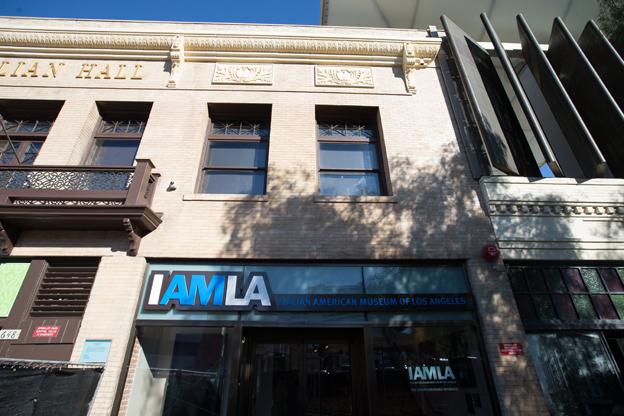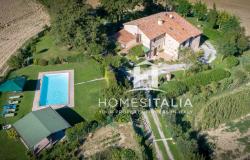[The Italian American Museum of Los Angeles highlights the history and contributions of Italian Americans in multiethnic Southern California. Photo credit IAMLA.]
For anyone interested in learning about the history of Italians in the greater Los Angeles area, the Italian American Museum of Los Angeles (IAMLA) is the place to start.
Opened in August 2016, after many years in the making and a few setbacks along the way, the IAMLA is located in the Italian Hall, the oldest remaining building from L.A.’s Little Italy.
You may be surprised to hear that L.A. had a Little Italy; indeed, the area where Italians settled starting in the 19th century, today’s Downtown LA, has undergone so many changes after the 1950s that almost nothing has survived from the times when Italians were one of the major ethnic groups to live there.
It is then especially fitting to house such a significant cultural institution for the history of Italian Americans in one of the rare buildings to have survived, a building that, from 1908 to 1950, represented the main social center for the Italian community of L.A.
The 5,000-square-foot interactive museum features seven exhibitions arranged chronologically and thematically. Large glass panels provide an overview of each exhibition, while tablets attached to cases provide more in-depth information. Artifacts, images and historical documents bring history to life, highlighting both the struggles and achievements of Italian Americans in Southern California.

[Inside the Italian American Museum of Los Angeles. Photo credit IAMLA.]
The first three exhibitions explore the early history of Italians in Los Angeles, when the earliest Little Italies could be found in the Plaza area (today part of El Pueblo of Los Angeles Historical Monument), present-day Chinatown and Lincoln Heights, as well as San Pedro, Los Angeles’ historic waterfront to the south. Little evidence of these historic enclaves remains today, which makes the visit to the museum all the more fascinating.
The fourth exhibition is devoted to the Italian Hall, how it has changed over the years, how it almost risked being demolished, and how a passionate group of local Italian Americans got together to save it from oblivion.
The fifth exhibition, called Dago!, illustrates the history of Italian discrimination in the U.S., showing what Italians had to endure in their adopted country, especially during World War II when they were called enemy aliens. “I think this exhibition has a great potential to contribute to the national discourse on immigration,” IAMLA’s Executive Director Marianna Gatto told me during a visit of the museum last fall. “Our museum is about the immigration experience, and I see visitors of all generations, of all origins saying, that’s my family story. It’s great to build those bridges especially at these times of anti-immigration sentiment.”
The sixth exhibition, Italians in Hollywood, analyzes how Italians played a major role in the development of the movie industry behind the camera, but, on screen, their portrayal was, and still is, largely negative, or, at the least, stereotypical.
The last exhibition explores Italian American culture and famous Italian Americans, such as Simon Rodia, the creator of the Watts Towers, author John Fante, musician Frank Zappa, with memorabilia items, including Fante’s pipe and Tommy Lasorda’s Dodgers jersey, among many others.
The Italian American Museum of Los Angeles is located at 644 North Main Street. Open Tuesday-Sunday 10 am – 3 pm. Entrance is free; donations are encouraged. The IAMLA permanent exhibit content is available online through the Google Cultural Institute.
Italians started moving to the sprawling suburbs of Los Angeles in the 1950s. There is no longer an area that is predominantly Italian, but if you want to find a little more Italian history, while you’re near the museum, you may want to check out:
- The Pelanconi House (17 Olvera St.), built between 1855 and 1857 by Italian vintner Giuseppe Covaccichi. In 1871, Lombardy-born Antonio Pelanconi bought the house and winery, giving it its present name. The building now houses a Mexican restaurant.
- St. Peter’s Italian Catholic Church (1039 N. Broadway), established in 1904. It was the religious center for members of the Italian community and still plays an important role in the religious life of many Italian Americans living in the area.
- The San Antonio Winery, founded in 1917 by Lombardy-born Santo Cambianica. Located in Lincoln Heights, just east of downtown (737 Lamar Street), it is L.A.’s oldest family-owned business. You can take a guided tour.
Farther away, you may not want to miss the Watts Tower, 17 interconnected steel and mortar spiraling structures located in Watts, a neighborhood in South Los Angeles, considered one of the nation’s finest works of folk art. It took Italian immigrant laborer Sabato Rodia 34 years to complete the structure using entirely recycled objects.
And why not learn to make Neapolitan pizza at VPN Americas, the North American delegation of the Associazione Verace Pizza Napoletana, a non-profit organization founded in Naples to safeguard the tradition and promote the culinary art of authentic Neapolitan pizza. VPN Americas recently relocated to Inglewood and offers both amateur and professional courses for aspiring pizzaioli.

The list of excellent Italian restaurants in LA is too long to include here. Piero Selvaggio’s Valentino in Santa Monica is sort of an institution in the restaurant industry of the U.S. so you may want to pay a visit, but of course there are many long-established and emerging restaurants in the city. To stay up-to-date with the L.A.-Italian food scene, follow Foodiamo.









